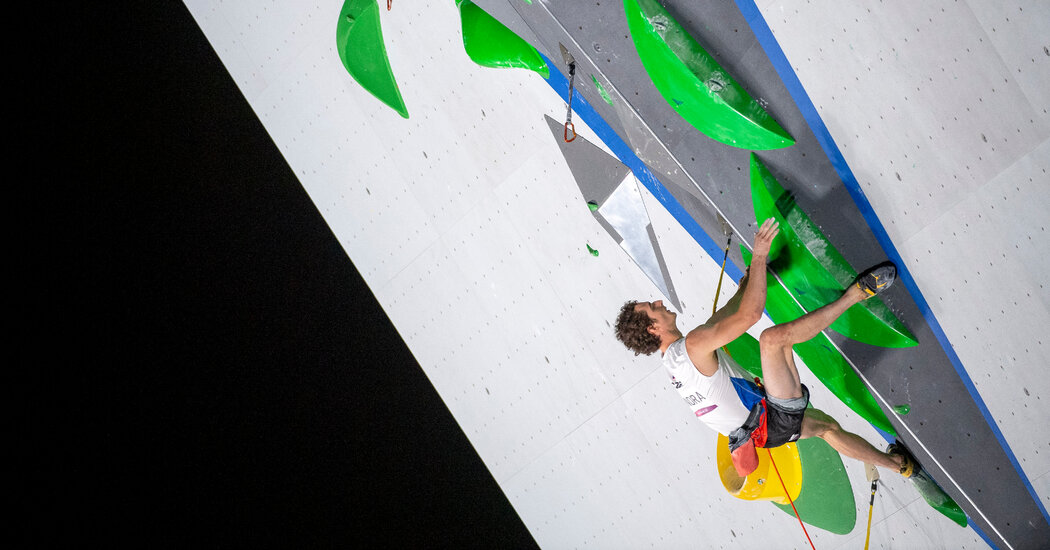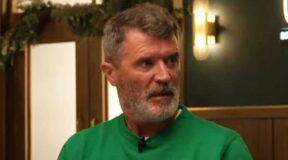TOKYO — Even if there were mountains in Tokyo, reasonable climbers would not venture into such midsummer heat and humidity to climb them.
Climbers tend to like cool and dry conditions, if given a choice. They hang by their fingers and often trust their body’s weight to a single point of contact — a toehold, a wedged elbow or knee, a patch of a calloused fingerprint.
Gravity is the enemy of climbing. Sweat, like fatigue, fear and impatience, is a secondary one. Moisture is a lubricant that no one wants.
All around the world, the athletes training for sport climbing’s debut in the Olympics tried to simulate the anticipated August conditions in Tokyo. In Brno, Czech Republic, Adam Ondra cranked the heat and turned his home climbing gym into a sauna in recent months. In Salt Lake City, members of the United States team trained in a small gym pumped with hot air and moisture, like a humidor.
On Tuesday, the start of four days of competition, temperatures at Aomi Urban Sports Park were in the low 90s Fahrenheit and humidity was about 70 percent. The heat index was well over 100 degrees.
It was not ideal, but hardly unexpected. The bigger surprises came in the results of the men’s qualifying round.
Ondra was not one of them. Considered the world’s best climber in both the realms of artificial-wall contests, like the Olympics, and big-wall expeditions on natural rock in mountainous places around the globe, Ondra finished fourth, advancing to the eight-man final scheduled for Thursday evening.
The conditions will continue to make it nerve-racking, especially in lead, the last of the three disciplines. It is where medals will be won and lost in real time, perhaps with an unexpected fall back to Earth.
“We know all these holds, so we know what it should feel like,” Ondra said. “And it feels like you’re just sliding off. You just don’t feel comfortable on a wall. You just have to forget about all the sweat and grease and just keep going. It’s a lot about running into a risk that you can just fall unexpectedly.”
Among 20 competitors, Ondra placed 18th in the speed portion of the event, third in bouldering and third in lead. Those results were multiplied together, in this event’s quirky scoring system, to establish the eight qualifiers. Scores are reset for the final.
More unexpected results came from the United States and France. Colin Duffy, the 17-year-old from Colorado, showed steely nerves and a strong grip to qualify third. His American teammate Nathaniel Coleman was eighth.
Also into the final were the Mawem brothers, Bassa and Mickael, of France. Bassa, 36, had the fastest time on the speed wall (5.45 seconds) and got into the final despite near-last place finishes in the other disciplines. (A biceps injury during the lead discipline could threaten to keep him out of the final.) Mickael, 31, was third in speed and, unexpectedly, first in bouldering, leading to the night’s top qualifying score.
Tomoa Narasaki of Japan, 25, a gold-medal favorite, finished second.
Among those who did not reach the final were some top names in sport climbing, like Alex Megos and Jan Hojer, both of Germany, and Jongwong Chon from Korea.
The women’s qualifiers are scheduled for Wednesday evening.
In most ways, sport climbing was just glad to be here, in central Tokyo, in the Olympics. Like skateboarding, surfing and BMX freestyle, climbing is part of an influx of action sports making Olympic debuts at these Summer Games. It is an attempt to bring more action and youth to the aging enterprise.
But the climbing world had two major issues with this debut, including the heat. The other was the format. Granted only one medal, the international federation was forced to choose which discipline to highlight: speed, boulder or lead.
Rather than choose, it created a combination event, three distinct climbing disciplines smashed into one. It was a bit like telling swimmers, cyclists and runners that they were not invited to compete in their individual events, but could try the triathlon.
Latest Updates
Tom O’Halloran of Australia called it a “pretty brutal format,” and compared it to combining the shot put, the 100-meter dash and the 800-meter run in track and field. On the plus side, he said, a different type of all-around athlete has emerged, as top climbers were forced out of their usual niches and comfort zones by their desires to compete in the Olympics.
The plan is to have at least two medals at the 2024 Paris Games — one for speed, and a combined event for boulder and lead, which have more skills and athletes in common. The hope is that there will be three medals eventually.
The federation created a combined scoring system where the finish of each athlete in each discipline was multiplied to create a total score. Someone who finished third in speed, boulder and lead, for example, would have 27 points (3x3x3). An athlete who finished first, third and seventh would have 21 (1x3x7). The system carries mathematical intrigue and produces unpredictable results.
The other major concern for this competition was Tokyo’s summer weather. When the International Federation of Sport Climbing held its world championships in suburban Hachioji in 2019, the event took place in an air-conditioned convention center. Most climbing World Cups are held outdoors in mountain communities, in places like the Rocky Mountains or the Alps, where the relatively cool air is rarely thick with humidity.
But Tokyo Olympic organizers wanted their new event outdoors, and so it was. The only concession was a 5 p.m. start and no direct sun. An evening breeze made things tolerable, but still warm and muggy by climbing standards.
“The biggest worry is definitely not slipping,” Duffy said. “And making sure to hydrate more and chalk up more than I would back in the States.”
The other issue is what the sandpaper-like holds do to fingers, usually hardened with callouses, made soft by the moisture. “It hurts a little bit more with the humidity,” Duffy said.
Speed was the first discipline, a timed race up a 15-meter wall, where the holds are the same for every competition. It is the easy-to-understand, difficult-to-do outlier of sport climbing. Most of those who qualified for the Olympics excel in the other events, and have spent the past year or two learning the sequence of muscle memory and upward momentum required.
Ondra lumbered up in 7.46 seconds, a good time for him but far from world-class. He was 18th, a multiplier that put pressure on him to do well in the other events.
The second discipline was bouldering, an event of strength, imagination and contortionism. Athletes try to reach the top of four boulder problems, performed without ropes, with falls ending on a padded mat. Attempts are unlimited before the buzzer.
Ondra completed two of the problems (called a “top”), and halfway up another (called a “zone”), better than all but two competitors. That put him in sixth place through two disciplines.
The final discipline, lead, is the classic climbing event, up a high wall, using ropes only to catch a fall. The goal is to go as high as possible before exhaustion and gravity win.
It is Ondra’s best event, the most like the outdoor climbing that he does better than anyone. He methodically scaled most of the wall, much of it inverted, all of it getting harder as the further he ascended.
When he slipped near the top and was belayed back to the ground, Ondra suspected it was good enough to get him to Thursday with his medal hopes intact. He was right.
But it was not easy, for Ondra or any of the others. The quest for a medal in this quirkiest combination of disciplines can end without warning, a bigger concern than usual in Tokyo’s trying conditions.
That will not change. The forecast for the rest of the competition remains the same: hot, humid and a strong chance of scattered slips.
Sport
Climbing:
Men’s
Combined
›
Speed
Bouldering
Lead
Total
Mickael Mawem
Tomoa Narasaki
Colin Duffy
Jakob Schubert
Adam Ondra
Alberto Gines Lopez
Bassa Mawem
Nathaniel Coleman
Alexander Megos
Chon Jongwon
Source: Read Full Article






